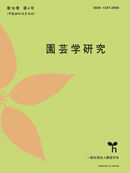Volume 16, Issue 4
Displaying 1-16 of 16 articles from this issue
- |<
- <
- 1
- >
- >|
REVIEW
-
2017Volume 16Issue 4 Pages 373-381
Published: 2017
Released on J-STAGE: December 31, 2017
Download PDF (4447K)
REPORTS
Breeding & Germplasm Resources
-
2017Volume 16Issue 4 Pages 383-390
Published: 2017
Released on J-STAGE: December 31, 2017
Download PDF (4976K) -
2017Volume 16Issue 4 Pages 391-400
Published: 2017
Released on J-STAGE: December 31, 2017
Download PDF (2508K) -
2017Volume 16Issue 4 Pages 401-408
Published: 2017
Released on J-STAGE: December 31, 2017
Download PDF (1956K) -
2017Volume 16Issue 4 Pages 409-414
Published: 2017
Released on J-STAGE: December 31, 2017
Download PDF (9878K)
Propagation & Transplant Production
-
2017Volume 16Issue 4 Pages 415-420
Published: 2017
Released on J-STAGE: December 31, 2017
Download PDF (2283K)
Soil Management, Fertilization & Irrigation
-
2017Volume 16Issue 4 Pages 421-434
Published: 2017
Released on J-STAGE: December 31, 2017
Download PDF (1824K) -
2017Volume 16Issue 4 Pages 435-441
Published: 2017
Released on J-STAGE: December 31, 2017
Download PDF (11768K)
Crop Production & Cropping Type
-
2017Volume 16Issue 4 Pages 443-448
Published: 2017
Released on J-STAGE: December 31, 2017
Download PDF (1030K) -
2017Volume 16Issue 4 Pages 449-454
Published: 2017
Released on J-STAGE: December 31, 2017
Download PDF (2243K) -
2017Volume 16Issue 4 Pages 455-463
Published: 2017
Released on J-STAGE: December 31, 2017
Download PDF (1366K) -
2017Volume 16Issue 4 Pages 465-470
Published: 2017
Released on J-STAGE: December 31, 2017
Download PDF (1141K) -
2017Volume 16Issue 4 Pages 471-477
Published: 2017
Released on J-STAGE: December 31, 2017
Download PDF (1178K)
Postharvest Physiology & Technology
-
2017Volume 16Issue 4 Pages 479-485
Published: 2017
Released on J-STAGE: December 31, 2017
Download PDF (1034K)
Human Issues & Methodology in Horticulture
-
2017Volume 16Issue 4 Pages 487-496
Published: 2017
Released on J-STAGE: December 31, 2017
Download PDF (3828K)
Disease & Pest Management
-
2017Volume 16Issue 4 Pages 497-502
Published: 2017
Released on J-STAGE: December 31, 2017
Download PDF (1042K)
- |<
- <
- 1
- >
- >|
